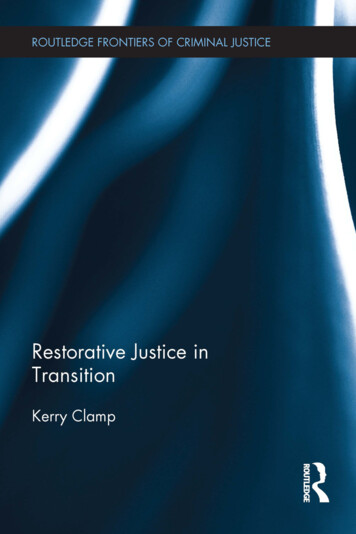
Transcription
A comprehensive scholarly engagement with the key issues of restorative justicein transitional settings. Students of transitional justice will find this an analytically incisive introduction to the restorative justice vision and challenges forpeace building.John Braithwaite, Australian National University, AustraliaFor anybody who is interested in the fields of peace-making, transitional justiceand restorative justice, Kerry Clamp’s book Restorative Justice in Transition isan absolute must. It should be on the desk of every serious scholar with aninterest in these areas.Elmar G.M. Weitekamp, PhD, Institute of Criminology,University of Tuebingen, Germany
This page intentionally left blank
Restorative Justice in TransitionThis book explores how restorative justice is used and what its potential benefitsare in situations where the state has been either explicitly or implicitly involvedin human rights abuses. Restorative justice is increasingly becoming a popularmechanism for responding to crime in democratic settings, and while there is aburgeoning literature on these contexts there is less information that focusesexplicitly on its use in nations that have experienced protracted periods of conflict and oppression.This book interrogates both macro- and micro-utilisations of restorativejustice including truth commissions, criminal justice reform and the developmentof initiatives by communities and other non-state actors. The central premise isthat the primary potential of restorative justice in responding to internationalcrime should be viewed in terms of the lessons that it provides for problemsolving, rather than its traditional role as a mechanism or process for respondingto conflict. Four values are put forward that should frame any restorativeapproach – engagement, empowerment, reintegration and transformation. It isthought that these values provide enough space for local actors to devise theirown culturally relevant processes to achieve longstanding peace.This book will be of interest to those conducting research in the fields ofrestorative justice, transitional justice and criminology in general.Kerry Clamp is a Lecturer in Criminology in the Department of Social Sciencesand Psychology at the University of Western Sydney. She received her PhDfrom the University of Leeds in 2010 and also holds degrees from the Universityof Sheffield and the University of South Africa. Dr Clamp’s research agendafocuses on restorative justice and transitional justice. Her research appears in anumber of journals including the British Journal of Community Justice (2011),Nottingham Law Journal (2012), International Criminal Law Review (2012),Northern Ireland Legal Quarterly (2012), and Criminology and Criminal Justice(2012). Dr Clamp is also the Chair of the Editorial Board for the EuropeanForum for Restorative Justice, a role that she has held since January 2011.
Routledge frontiers of criminal justice1 Sex Offenders, Punish, Help, Change or Control?Theory, policy and practice exploredEdited by Jo Brayford, Francis Cowe and John Deering2 Building Justice in Post-Transition EuropeProcesses of criminalisation within Central and Eastern European societiesEdited by Kay Goodall, Margaret Malloch and Bill Munro3 Technocrime, Policing and SurveillanceEdited by Stéphane Leman-Langlois4 Youth Justice in ContextCommunity, compliance and young peopleMairead Seymour5 Women, Punishment and Social JusticeHuman rights and penal practicesMargaret Malloch and Gill McIvor6 Handbook of Policing, Ethics and Professional StandardsEdited by Allyson MacVean, Peter Spindler and Charlotte Solf7 Contrasts in PunishmentAn explanation of Anglophone excess and Nordic exceptionalismJohn Pratt and Anna Eriksson8 Victims of Environmental HarmRights, recognition and redress under national and internationalMatthew Hall9 Doing Probation WorkIdentity in a criminal justice occupationRob C. Mawby and Anne Worrall
10 Justice ReinvestmentCan the criminal justice system deliver more for less?Chris Fox, Kevin Albertson and Kevin Wong11 Epidemiological CriminologyTheory to practiceEdited by Eve Waltermaurer and Timothy A. Akers12 Policing citiesUrban securitization and regulation in a 21st century worldEdited by Randy K. Lippert and Kevin Walby13 Restorative Justice in TransitionKerry Clamp
This page intentionally left blank
Restorative Justice inTransitionKerry Clamp
First published 2014by Routledge2 Park Square, Milton Park, Abingdon, Oxon OX14 4RNSimultaneously published in the USA and Canadaby Routledge711 Third Avenue, New York, NY 10017Routledge is an imprint of the Taylor & Francis Group, an informa business 2014 Kerry ClampThe right of Kerry Clamp to be identified as author of this work has beenasserted by her in accordance with sections 77 and 78 of the Copyright,Designs and Patents Act 1988.All rights reserved. No part of this book may be reprinted or reproduced orutilised in any form or by any electronic, mechanical, or other means, nowknown or hereafter invented, including photocopying and recording, or inany information storage or retrieval system, without permission in writingfrom the publishers.Trademark notice: Product or corporate names may be trademarks orregistered trademarks, and are used only for identification and explanationwithout intent to infringe.British Library Cataloguing in Publication DataA catalogue record for this book is available from the British LibraryLibrary of Congress Cataloging-in-Publication DataClamp, Kerry.Restorative justice in transition / Kerry Clamp.pages cm. – (Routledge frontiers of criminal justice)1. Restorative justice. 2. Victims of crimes. 3. Human rights.4. International crime. I. Title.HV8688.C53 2014364.6'8–dc232013012487ISBN: 978-0-415-52371-4 (hbk)ISBN: 978-0-203-71519-2 (ebk)Typeset in Times New Romanby Wearset Ltd, Boldon, Tyne and Wear
For Danny, who put up with me and provided a sounding boardfor many of the ideas contained in this book.
This page intentionally left blank
ContentsForewordAcknowledgementsList of abbreviations1IntroductionEvolving discourses in transitional justice 2Restorative justice in transitional contexts 4Outline of the book 82Restorative justice as a contested response to conflict andthe challenge of the transitional contextPrinciples, values and goals of restorative justice: a briefoverview 11The complexities of restorative justice 12Challenges for restorative justice as a response to massvictimisation 18A way forward 30xiiixvxvii1103The value of restorative justice for transitional settingsStriving for ‘transformation’ in transitional settings 32From concepts to practice 46314Restorative justice in transition: a multi-layered approachDirections of change 49Universalism versus local tradition 60The role of restorative justice in transitional justice 65485Restorative justice as a mechanism for nation-buildingRestorative justice and ‘top-down’ transitional justicemechanisms 6968
xii ContentsConceptual confusion and the contested claims of restorativejustice in the transitional context 71Untapping the potential of ‘top-down’ restorative justicemechanisms 84From backward-looking to forward-looking agendas 866Restorative justice as a vehicle for reformReforming justice: trends and obstacles 88From formal to informal responses to conflict 997Restorative justice as a mechanism for peace-buildingCommunity as a stakeholder in restorative justice 102The challenge of ‘community’ in transitional settings 105The potential of the restorative ‘community’ in transitionalsocieties 109Some final thoughts 114Conclusion: towards a transformative vision of restorativejusticeMacro and micro-utilisations of restorative justice 116The impact of restorative justice 120NotesReferencesIndex87101116124130154
ForewordFew can have failed to have noticed the prolific expansion of restorative justiceover the past two decades. While the parameters of the concept remain somewhat contested, there can be little doubt that policymakers on both national andinternational platforms are actively seeking ways to promote more effective andmore legitimate responses to criminal offending. This shift is, in part, a responseto growing doubts concerning the capacity of orthodox criminal justice systemsto deliver participatory processes and fair outcomes that are capable of benefiting victims, offenders, communities and, indeed, society as a whole. There is noshortage of literature exploring both the theory and practice underpinning restorative justice in its many guises; its expansion has been particularly well-chartedin Australia, New Zealand, North America, England and Wales and (increasingly) continental Europe. Innumerable evaluations consistently show that it outperforms orthodox approaches to criminal justice across range of variables.Yet we know considerably less has been written about the evolution of restorative justice in so-called transitional societies. This is in spite of the welldocumented paradigmatic overlap that exists between restorative justice andtransitional justice: both approaches tend to emphasise inclusive and nonadversarial frameworks for conflict resolution, and both espouse similar values,such as truth, accountability, fairness, respect, reparation, reconciliation andparticipation. At one level, it is clear that aspects of restorative justice oftenfeature prominently at a societal level within certain conflict-resolution mechanisms; the archetypal truth commission is one such example. Whilst there isundoubtedly a growing interest in the potential utility of restorative justice insuch settings, there remains a dearth of close analysis as to how restorative suchprocesses are in practice. By the same token, we know very little about theextent to which restorative principles might, integrated into the new democraticinstitutions, have emerged from conflict-resolution processes. Key questionsconcern: what drives/impedes the use of restorative justice in transitional environments? Is there a relationship between the use of restorative justice withinnew criminal justice systems and legitimacy? What is the relationship (if any)between the use of restorative justice at a macro or inter-communal level and itsuse as a tool for resolving conflicts between individuals at the micro level?Might its adoption (at either level) propel the transition through providing better
xivForewordlevels of transparency, accountability and community participation? Are thererisks that the state might seek to ‘colonise’ localised and grassroots initiatives?If so, how might these be counteracted? How might the use of restorative justiceimpact among the attitudes and experiences of stakeholders? How might themainstreaming of restorative approaches within criminal justice impact on levelsof crime and recidivism?Dr Clamp’s book proffers a very clear lens through which such issues mightbe probed in greater depth through offering an accessible, yet highly rigorousanalysis of the problem-solving potential of restorative justice. There are two keyobjectives to her book: first, to explore the impact of transition upon the development of restorative justice and, second, to analyse the inverted impact of restorative justice upon the transition. Drawing from the themes of her earlier doctoralwork which explored three transitional societies (the Czech Republic, NorthernIreland and South Africa), Clamp examines the use of restorative justice at macrolevel; as a feature of criminal justice reform and at grassroots level. Overall, alucid and convincing argument is presented that whilst there is no ‘one size fitsall’ solution, four core values may be elicited which maximise the problemsolving potential of restorative justice in transitional settings, these being engagement, empowerment, reintegration and transformation. These values, in turn, maybe used to provide democratic space for communities to adopt culturally-relevantprocesses which hold the potential to create and sustain peace.Restorative Justice in Transition is a timely and most welcome addition to arelatively sparse body of literature which should prove an invaluable resourcefor those interested in transitional justice, criminology and conflict resolution.Professor Jonathan DoakDurham Law SchoolApril 2013
AcknowledgementsWriting this book has been a difficult process. The literature on both restorativejustice and transitional justice is enormous and this contributed to an everpresent sense that something important would be forgotten or overlooked. Thiswas compounded by juggling the demands of teaching, getting married andmoving from the UK to take up a new post in Australia. Nevertheless, there havebeen many people who have helped me to form my ideas, discuss the structurefor the book and to have a drink with along the way and thus kept me sane.The arguments based in the book have evolved from what was my PhD thesis,a journey undertaken at two institutions under the supervision of three inspirational academics. The obvious place to begin with my thanks therefore is at theUniversity of Sheffield, where my journey began, with Professor James Dignanand Professor Jonathan Doak guiding and facilitating the genesis of what todayis my first monograph. Both Professor Dignan and Professor Doak have beeninstrumental, not only in terms of academic input, but also with unwaveringsupport and encouragement when things were not going quite to plan.A large debt is owed in particular to Professor Adam Crawford at the University of Leeds who took up the reins during the second year of this project untilits completion. His authority and breadth of knowledge on the subject has meantthat all methodologies, arguments and perspectives that I have put forward alongthe way have been challenged and expanded as a result. I am also personallyindebted to the interviewees who found the time in their busy schedules to speakto me. Without their contribution, the much needed depth and insight into theissues and events discussed herein would not have been possible. I am alsothankful for the comments and ideas put forward by my external examiners –Professor Kieran McEvoy and Professor David Wall – who provided helpfulfeedback and constructive criticism.I am very grateful to the anonymous reviewers who provided encouragingand constructive feedback on earlier drafts of the manuscript. I was also luckyenough to be invited to present my ideas at the Leuven Institute of CriminologyResearch Line on Restorative Justice in December 2012, and the discussion thatarose from that meeting helped me to develop my ideas further. As such, I wouldlike to thank all of those who attended, but especially Professor Ivo Aertsen andDr Inge Vanfraechem who invited me. Despite the help I have received along
xviAcknowledgementsthe way, writing is a necessarily selective process and any errors or omissionsnaturally remain my own.Professor Doak and Dr David O’Mahony, in particular, have provided muchneeded support and guidance since the completion of my degree, coupled withlots of shenanigans to keep everything in perspective – thank you both verymuch. I feel very lucky to have you both as mentors! My colleagues at SheffieldHallam University – Paula Hamilton, James Banks, Craig Paterson and ShawnaMcCoy; my PhD colleagues Daphne Kaklamanou and Ryan Davenport; mymates Aimee Flatt and Fiona Goldrick; and my little sister Brit Clamp alsodeserve a mention for constantly checking up on me. Without the love, supportand assistance provided by you all, I would not have completed what ultimatelyhas been the biggest professional challenge that I have faced.Finally, mention must be made of my mom, whose only wish has been for meto be the best that I can be (even if that meant being a beach bum!) and my dadwho has constantly motivated me to strive for more. You have both instilled mewith the belief that anything in life is possible. A special mention should bemade of my husband Danny. You have provided much needed support andencouragement throughout this journey and exercised what can only be describedas the patience of a saint – words just aren’t enough.
JTIRATRCUDFUNCRCVORPsArdoyne Community Project (Northern Ireland)African National CongressWar Crimes Chamber of the Court of Bosnia and HerzegovinaCommission for Reception, Truth and Reconciliation (TimorLeste)Criminal Justice Inspectorate Northern IrelandCommunity Peace Consolidation Committees (Red Cross, SierraLeone)Community Restorative Justice IrelandDemobilisation, disarmament and reintegrationDemocratic Republic of CongoFamily group conferencingInternational Criminal CourtInternational Criminal Tribunal of RwandaInternational Criminal Tribunal of YugoslaviaNon-governmental organisationNorthern Ireland Association for the Resettlement of OffendersNorthern Ireland OfficeInternational Covenant on Civil and Political RightsPeople against Gangsterism and Drugs (South Africa)Probation and Mediation Service (Czech Republic)Post-traumatic stress disorderRecovery of Historical Memory, Recuperación de la MemoriaHistórica (Guatemala)Social Democratic and Labour Party (Northern Ireland)Association for Development of Social Work in Criminal Justice(Czech Republic)Tim Independen Rekonsiliasi AmbonTruth and Reconciliation Commission (South Africa)United Democratic Front (South Africa)United Nations Convention on the Rights of the ChildVictim Offender Reconciliation Programmes (Canada,specifically Ontario; USA, specifically Indiana)
This page intentionally left blank
cally incisive introduction to the restorative justice vision and challenges for peace building. John Braithwaite, Australian National University, Australia For anybody who is interested in the fields of peace-making, transitional justice and restorative justice, Kerry Clamp's book Restorative Justice in Transition is an absolute must.


![Upskilling and Structuring [Teams] for Predictive Analytics](/img/11/pd-2018-insurtech-session-6.jpg)


